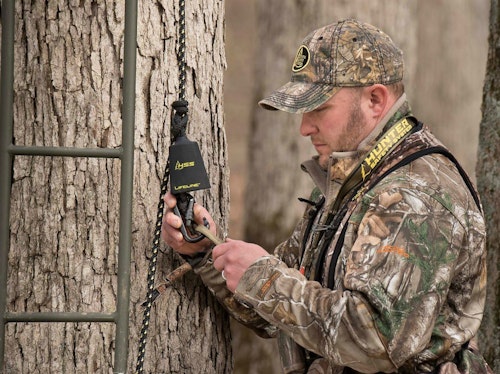First, a confession: I’m terrified of heights. You should be too — especially if you hunt from a treestand, like 97 percent of whitetail bowhunters (and 84 percent of whitetail gun hunters) in Wisconsin do, according to the state DNR.
The reason hunting from treestands scarifies me is simple: Did you know that when a person is hanged to death, the standard drop is less than 6 feet? Now imagine falling 20 feet from a treestand. It just takes one “Holy smokes!” moment, a millisecond of inattention, one slip of the foot or hand, and you could be crippled for life or dead.
There was a time when most hunting injuries revolved around firearms. Using Wisconsin as an example, in 1914, 24 hunters died due to firearms accidents. In 2018, there were three non-fatal shooting injuries during the Wisconsin gun deer season. In North Carolina in 2017, 22 serious hunting accidents were reported, including three fatalities. All were treestand related.
In March 2018, New York’s Department of Environmental Conservation released its first-ever summary of treestand-related accidents for the prior hunting season. The types of treestand involved were climber (two), hang-on (four), ladder (two) and homemade (four). A summary of the incidents investigated paints an interesting picture.
A Few From the New York Report
- 10/27: Monroe County. Fatality. No harness. Hang-on treestand. Hunter was entering or exiting stand. Age 35.
- 11/8: Monroe County. No harness. Ladder Stand. While sitting in stand, one of the nylon straps for the suspended seat failed, causing the individual to list to one side and fall 20 feet to the ground. Age 58.
- 11/17: Delaware County. No harness. Homemade treestand. Victim was in stand when it broke away from the tree and collapsed. Age 68.
- 11/18: Cayuga County. Fatality. No harness. Hunter was climbing tree when top tree loop broke at 16 feet. Stand was old and rusted. Age 54.
- 11/20: Washington County. Fatality. Harness used. Homemade treestand. Hunter was attempting to attach his safety harness when the wooden platform collapsed. Age 73.
- 11/25: Broome County. Harness used. Ladder stand. Hunter was climbing down from his stand when he slipped and fell. He was wearing his harness while in the stand. Age 45.
- 12/3: Cortland County. No harness. Climbing treestand. Victim fell from 15-20 feet while climbing with his treestand due to an unsecured safety latch pin and lack of an attached safety harness. Age 42.
- 12/3: Oneida County. Harness used. Victim fell out of his stand when the hanging strap holding the platform broke and he fell 14 feet. Age 32.
Can you see the problems? All these accidents revolved around carelessness (not wearing a harness or not attaching the harness to the tree), or using an old and/or poorly maintained treestand. Why anyone would hunt today from an old homemade treestand made from rotten wood is baffling. A quick online search will show you a pile of similar accident reports from other states. Many of those who survive falls have serious injuries or have been paralyzed.
At the 2019 Archery Trade Association show in Louisville, I spent an hour or so talking with my friend, Jerry Wydner, who along with his brother, John, started Hunter Safety Systems (www.huntersafetysystem.com) back in 2001 after John fell while not wearing the safety strap provided. Since then, they’ve been tireless crusaders for treestand safety and the importance of “staying connected” to the tree from the ground up and down using both a Lifeline and full-body harness. Part of that conversation revolved around the need for treestand safety to become a standard part of all state hunter and bowhunter education programs going forward.

Years ago, I was filming one of those outdoor cable TV shows in Kentucky with a hard-headed cameraman who refused to wear a harness. After 8 hours of no action I sensed something, turned around and saw the man fast asleep and starting to tip over backward. We were 25 feet up. I was able to grab him before he let loose. All I said was, “Please don’t make me have to call your wife and tell her you’re dead, or crippled.” I climbed down, and when he refused to wear a harness still, I went home.
When afield — and especially when using a treestand — my thought process is simple: What could go wrong with my next move that could kill me?
My treestand rules are to always maintain three points of contact at all times with hands and feet when ascending/descending, make sure my boots are free from mud, ice or some other slippery something, and to always use the Lifeline and a full-body harness in good repair. And I never, ever hunt from an old homemade wooden stands, or metal stands that obviously are in disrepair.
Have you ever fallen from a treestand or come close? Had a friend fall? I’d love to hear about your experience. Email me at editor@grandviewoutdoors.com and share your story.






